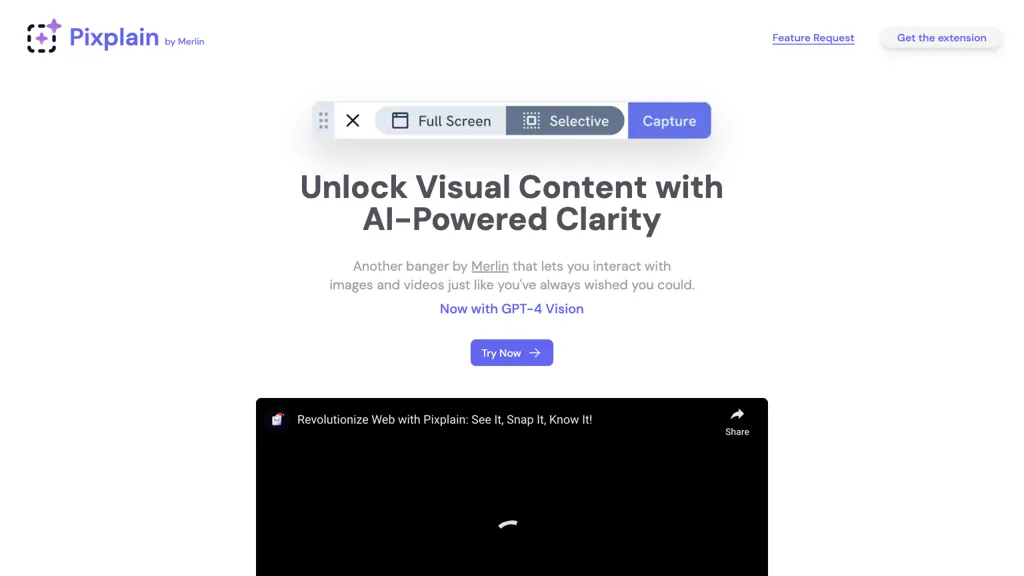What is Pixplain?
Pixplain is the next-gen AI interactive tool for visual elements, be it an image or a video. At the heart of the concept is the user’s ability to capture area snapshots on the screen around elements of their choice and ask relevant questions to that element after hovering the mouse over or selecting a piece of it that would receive elaborate answers on a given question using the power of all the latest AI models like GPT-4, GPT Vision, Claude, and Llama. Integration is smooth, and experience by all means is a flawless affair on a user’s end.
Key Features and Benefits of Pixplain
- It has an intuitive interface to make the system easier to navigate.
- Interactivity of the visual content—engaging people dynamically around images and videos.
- It is an integration as a browser extension—easy to add to the browser and easily accessible.
- Screen area selection: snap and question areas focused on later.
- Top AI models: Best in the world with the latest technology interfaces from GPT-4 to GPT Vision, Claude to Llama.
- Pixplain offering an enriched online learning experience, blurs virtual collaborations better, and optimizes customer support.
- This would be the most relevant to professionals in diversified applied sectors, whose deep analytic feedback needs the clarity of being AI-driven.
Use Cases and Application of Pixplain
-
Online education space:
Students can get to the depth of it all with image and video content to clearly get the message of the hard content. -
Virtual Collaboration:
It allows for the capturing and sharing of visual feedback with just the click of the button, hence allowing the ease in collaboration. -
Customer Support:
The same enables customer service support agents to capture and annotate screenshots at super speed and, in turn, AI-generated responses to troubleshoot.
The cases of use include the areas of education, design, and customer service.
How to use Pixplain
Pixplain is pretty easy to use. Here is how you do it:
- Add your extension going to Pixplain extension on your browser bar or clicking on «add to Chrome».
- Screen only the areas that are relevant to you.
- Ask a question or inquire about the images or videos you’ve uploaded.
- Ask detailed questions for the best AI models.
This would work best if you are able to screen a relevant, clear part on the screen and ask detailed questions.
How Pixplain Works
Pixplain incorporates visual information and provides profound insight with the most advanced AI available to it. Deep technology that propels the system is across extremely complicated algorithms and models containing GPT-4, GPT Vision, Claude, and Llama. As per the workflow for this system, it involves a clear screenshot on part of the screen, sending a question, and getting an answer based on AI insights and feedback.
Pros and Cons of Pixplain
Pros:
- Very friendly user interface
- Easy Integration into Browsers
- Dynamic interaction with images and videos
- Access to state-of-the-art AI model enabling deep analysis of the content.
Potential Drawbacks:
- End user not used to AI tools, so there is a learning curve
- Highly dependent on internet connectivity
User reviews claim Pixplain to be effective and efficient in adding value to visual content interaction, although the first has a learning curve for the user.
Common User Concerns on Pixplain
Q: How do you get Pixplain to my browser?
A: Go to the Pixplain website and download the extension for your preferred browser and then follow in-website prompts to install it on your web browser.
Q: Does Pixplain allow the service to be run on both Images and Video?
A: Yes, users can run both images and video with the Pixplain service.
A:
Pixplain operates with high-level AI models, such as GPT-4, GPT Vision, Lucy, Claude, and Llama.
A:
Pixplain is pitched to a design-friendly interface, so it is intuitive. However, as a general rule, when interacting with AI tools for the first time, there is often a learning curve.
Q: Should I be connected to the internet to use Pixplain?
A: Yeah, one needs an internet connection to access the AI models and bring back the responses.










